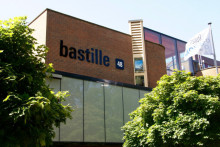Nevertheless ‘going Dutch’ by becoming a regular cyclist can present great challenges ― from finding an affordable bike and keeping it from being stolen to understanding the sometimes complex traffic rules. The UT Nieuws explores the Dutch world of cycling to help foreign students avoid painful injuries and cycle without incurring steep fines.
Buying a bike
Prices to purchase a new bike start at € 275, while a second-hand bike usually costs € 75 to € 175. Used bikes can be bought from various bicycle shops, including Rijwielshop Enschede, located below the train station, and Ten Tusscher on the Oldenzaalsestraat. The popular Dutch equivalent to e-bay, marktplaats.nl can also be a good place to look. Be aware of the difference between dames-en herenfietsen (ladies and men’s bikes). Ladies’ bikes usually come with a step-through frame, unlike the traditional diamond-frame equipped gent’s bike.
Theft and parking
Every year about half a million bikes are stolen in the Netherlands. To prevent theft, get a solid chain or pad lock to tie your bike to a pole or something else solid when ‘parking’ it. In the city center, you can also park free-of-charge in the guarded bicycle garages at the Van Heekplein, below the V&D store, and on the Brammelerstraat. If you have difficulties spotting your bike among hundreds then buy a brightly colored lock or ‘pimp’ your bike by painting it with spray paint.
Collision-free cycling
When you are new to cycling, keep to the right of the road and where possible and stay on the cycle paths. At crossroads, traffic coming from the right always takes precedence, including you on your bike, unless traffic lights or signs indicate differently. You can look down on the pavement to see ‘shark’s teeth’ or white triangles that show priority. You must yield to traffic when the ‘teeth’ are pointing towards you. After entering a roundabout, make sure to hold your arm towards the middle until you’re ready to exit the roundabout.
Hold out your right arm when turning right, or the left one for the opposite direction. Upon entering a street, give priority to any pedestrians about to cross the street, indicated sometimes by a zebrapad or crosswalk. In the city, you can ride your bike with your friend cycling next to you, outside built-up areas only when not hindering other traffic.
You are never allowed to cycle on pavements. A round blue sign with a white pedestrian on it shows a pedestrian-only zone, and you should step-off your bike.
Lights on your bike
When riding in the dark, adequate bicycle lighting is a must to see what’s in front of you and to be clearly seen by other cyclists and motorists. If your bike doesn’t have ‘working’ lights, you can be fined. Small, removable lights can be purchased at a bicycle dealer or at Hema and Action stores. White lights must be on the front and red ones on the rear of your bike. If your original lights are malfunctioning, simply attach these clip-on lights to either your bike or onto your jacket and backpack. Finally, your bike should have a red rear reflector and wheels equipped with yellow or light-reflection strips.
Police policy
Fines for breaking rules can vary from € 35 for inadequate lighting to € 20 for not having proper reflectors. Cycling home after consuming a couple of beers is certainly tolerated, but when you are swaying so severely that you endanger yourself and other traffic, you will pay at least € 100 fine. Note down the frame number and brand name ofyour brand-new bike; it can help the police to identify it when lost or stolen.
Biking culture
Even if it may be wiser to wear one, helmets are not commonly worn in the Netherlands. When another cyclist seems not to notice you, it is a good practice to ring your bell – rather than shout – to alert them of your presence. Finally, if you are being overtaken, in a seemingly effortless way by an elderly cyclist, do not feel too disheartened. You probably just witnessed the latest fashion in Dutch biking: the electric bike – particularly popular among Dutch senior citizens.
Still not sure if biking is the thing for you after reading this article? Or do you need a temporary bike for visitors? Bikes are also for rent for about € 7.50 a day in Enschede at the Rijwielshop. Happy cycling.
UT Nieuws thanks Politie Twente for their assistance with this article.
 |
| Car versus bikes at the Pathmossingel-Getfertsingel junction. (Photo: Gijs van Ouwerkerk) |







